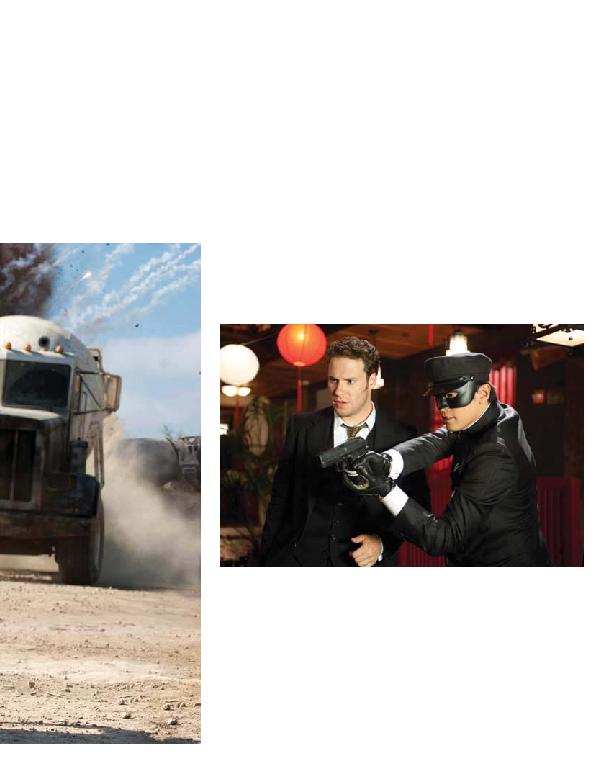
sic, recognizable sedan that fans knew and
loved. "In the end, the studio was going to go
with whatever Neal Moritz said," Goldberg re-
calls, "because he's the guy who developed
The Fast and the Furious. And, thank goodness,
Neal made the right choice."
of the script told an origin story." Following
their desire to be original, the screenwriters
thought it best to skip the "first movie" fran-
chise conventions and go right to the point
when Britt Reid and Kato had been vigilantes
emotional problems that they have now,"
Rogen explains. "We just made it like it was
building to this kind of emotional [crisis] that
they were having."
too many unanswered questions. "We also
started to realize we could have a lot of fun
with the origin aspect of it," Rogen says.
"That, in and of itself, we could reinvent and
subvert the notion of a superhero origin as op-
posed to just trying to avoid it altogether."
that it was on Superbad that we learned to be-
come outliners," Goldberg chuckles. Their goal
was to create an outline so detailed that any-
one would be able to pick it up and turn it into
the right script. This, in and of itself, is a two-
month project under normal circumstances,
but The Green Hornet was far from normal.
they showed it to different studio heads and
directors (original director Steven Chow left
the project and was replaced by Michel
Gondry). One version had Britt Reid and Kato
meeting in China. Another had an elaborate
frame story that began in the thick of the ac-
tion before it flashed back for a third of the
script. There were also drafts with the Green
Hornet fighting a super villain syndicate that
had put a price on his head and another that
involved elaborate arms deals with the mili-
tary. For some versions, Rogen and Goldberg
were creating outlines in just a few weeks.
ultimately took them close to two years.
Reid (Tom Wilkinson). When James dies from
an allergic reaction to a bee sting, Britt finds
himself bonding with the man who takes care
of his father's car collection, a mechanical ge-
nius and amazing barista by the name of Kato
(Jay Chou). After a drunken attempt to dese-
crate his father's grave leads to a thwarted
mugging, Britt decides the duo should find
purpose by becoming crime fighters -- not
publicly, though, like all those other super-
heroes in the movies. The two of them will
pose as criminals instead and "take over" Los
Angeles, taking out every level of crime with-
out exposing themselves and eventually work-
ing their way up to the city's uber-crime lord,
a man called Chudnofsky (Christoph Waltz).
Thus begins the legend of the Green Bee...
who Kato quickly renames The Green Hornet.
with a completely straight face. "You learn
that this guy's secretly been working for this
guy and secretly this guy killed this guy. It
made me really nervous because we'd never
done anything like that. I was amazingly
thankful and relieved when we finally showed
the movie to audiences and they totally went
along and really liked it."
project by pages or scenes, Goldberg and